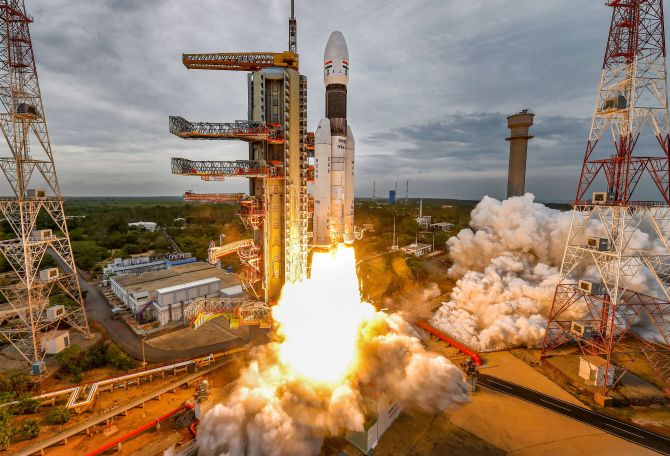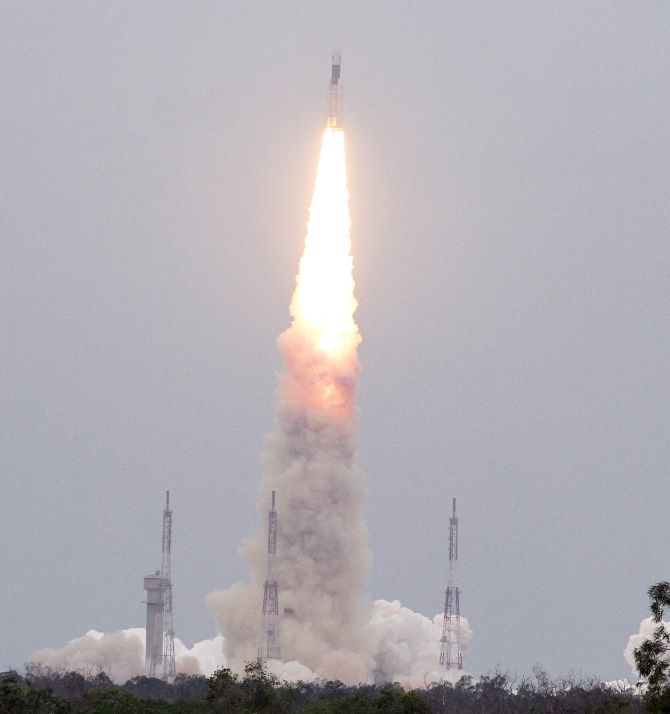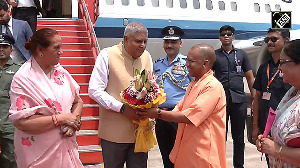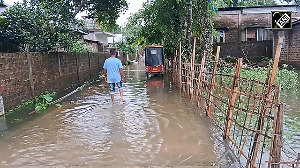The ISRO is aiming for a soft landing of the lander in the South Pole region of the moon where no country has gone so far.

India on Monday successfully launched its second moon mission Chandrayaan-2 from its most powerful rocket with a plan to land the rover on September 7 in the unexplored lunar south pole, exactly a week after the liftoff was aborted due to a technical snag.
Carrying a "billion dreams" in a giant leap for the country's ambitious low-cost space programme, the most complex and prestigious mission ever undertaken by the Indian Space Research Organisation, if successful, will also make India the fourth country after Russia, the United States and China to pull off a soft landing on the moon.
"We bounced back with flying colours after the earlier technical snag. Success is coming after a call-off," said a beaming and visibly relieved ISRO chairman K Sivan at the mission control room of the Satish Dhawan Space Centre in Sriharikota, about 100 km from Chennai, as scientists broke into cheers, shook hands and exchanged greetings.
WATCH: Chandrayaan-2 launched on board GSLV Mk-III- M1 from Sriharikota
Sivan, who announced the success of the mission, was addressing the scientists shortly after the towering geosynchronous satellite launch vehicle GSLV-MkIII-M1, dubbed as 'Baahubali', lifted-off from the second launchpad at the spaceport into cloudy skies at 2.43 pm and successfully placed the 3,850-kg Chandrayaan-2 into the earth orbit about 16 minutes later.
The Rs 978-crore unmanned mission also brought woman power to the fore as it was helmed by two woman scientists of the ISRO -- Ritu Karidhal and M Vanitha -- the Mission and Project directors respectively.
Joined by President Ram Nath Kovind and leaders across the political spectrum, Prime Minister Narendra Modi congratulated the scientists and said every Indian is immensely proud today.
In a series of tweets, Modi referred to the indigenous systems used in Chandrayaan-2 and said the mission is "Indian at heart, Indian in spirit!...
"Efforts such as Chandrayaan-2 will further encourage our bright youngsters towards science, top quality research and innovation."

The prime minister also shared pictures of him watching the launch on a large screen and shared his audio message to the ISRO.
"Chandrayaan-2 is unique because it will explore and perform studies on the south pole region of lunar terrain which is not explored and sampled by any past mission. This mission will offer new knowledge about the moon," Modi said.
The ISRO is aiming for a soft landing of the lander in the South Pole region of the moon where no country has gone so far.
Immediately after Chandrayaan-2's separation from the rocket, the solar array of the spacecraft automatically got deployed and the ISRO Telemetry, Tracking and Command Network at Bengaluru successfully took control of the spacecraft, the ISRO said in a statement.
According to the statement, Chandrayaan-2, a three-module spacecraft comprising orbiter, lander and rover, will be subjected to a series of orbit manoeuvres using its onboard propulsion system to take it to the vicinity of Moon over the next few weeks with the rover soft landing planned on September 7.
The mission was called off on July 15 barely an hour before the planned post-midnight lift-off after scientists noticed a glitch in the three-stage rocket during the propellant filling phase in the indigenous cryogenic engine, a decision that was welcomed as a prudent step by the Indian space fraternity.
WATCH: ISRO shares footage of onboard camera
Sivan said immediately after the technical snag was observed in an "intelligent way" one week back, the entire team swung into action.
"The work done in the next 24 hours to bring the vehicle back to normal was mind-boggling."
Scientists led by Sivan watched the launch sequence in rapt attention and broke into applause after every key stage of the rocket's flight which progressed precisely as programmed.
"It is the beginning of a historical journey of India towards the moon," Sivan said.
There will be 15 "very crucial manoeuvres" in the next one and half months before the satellite is brought around the moon, he said.

"After that the D-Day will come and on that day we are going to experience 15 minutes of terror, to ensure the landing is safe near the South Pole," he added.
"Chandrayaan 2 is ready to take a billion dreams to the moon now stronger than ever before! Join us for the launch on Monday 22 July, 2019 at 2:43 PM IST," ISRO tweeted on July 18 while announcing the rescheduled launch.
According to the ISRO, the lunar South Pole is an interesting surface area which remains in shadow than North Pole.
There is a possibility of the presence of water in permanently shadowed areas around it, the agency said, adding craters in the South Pole region have cold traps and contain fossil record of the early solar system.

Anxiety gave way to unbridled joy for thousands of space enthusiasts gathered here after the successful launch.
The 7,500 seat gallery set up by the ISRO to witness the rocket launch, a few kilometers away from the second launch pad, was full with those registering last week for the July 15 launch, rebooking their seats.
Chandrayaan-2 comes 11 years after ISRO's successful first lunar mission Chandrayaan-1 which scripted history by making more than 3,400 orbits around the Moon and was operational for 312 days till August 29, 2009.
The 43.43-metre tall three-stage rocket GSLV-MkIII-M1 dubbed as Baahubali for its ability to carry heavy payloads, successfully placed the Chandrayaan-2 in the Earth orbit, ISRO said.
From here onwards, the mission will undergo a series of manoeuvres by scientists to carry out different phases of the mission over the next 48 days.

Subsequent to the rescheduling of the launch, the space agency has tweaked the orbital phases, increasing Earth-bound phase to 23 days as against 17 days planned originally.
At the end of the Earth-bound phase, the orbit of the spacecraft will be finally raised to over 1.05 lakh km before nudging it into the Lunar Transfer Trajectory taking it to the proximity of Moon in the next two days.
Then gradually over the next few days it will be brought to 100 X 100 km circular orbit when the lander 'Vikram' carrying rover 'Pragyan' will separate and after another few days of orbiting it will make a soft landing at a chosen place on the Lunar surface.
"Chandrayaan-2 is the next leap in technology as we attempt to soft land close to South Pole of Moon. The soft landing is extremely complex...," Sivan had said.
The mission, which carries a total of 13 payloads, including three from the Europe, two from the US and one Bulgaria, seeks to improve understanding of the moon which could lead to discoveries that will benefit India and humanity as a whole.

A Laser Retroreflector Array of US space agency NASA is among the payloads and is aimed at understanding dynamics of Earths moon system and deriving clues on Lunar interior.
The lander Vikram, named after father of Indian space research programme Dr Vikram A Sarabhai, carrying the rover Pragyan, will be landed in a high plain between two craters at a latitude of about 70 degrees South of the moon.
Then the 27-kg Pragyan meaning wisdom in Sanskrit and a six-wheeled robotic vehicle, will set out on its job of collecting information on lunar surface.
A safe site free of hazards for landing would be decided based on pictures sent back by the camera onboard the lander and after touchdown the rover will carry out experiments for 14 Earth days, equalling one Lunar Day.






